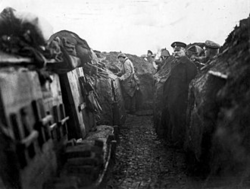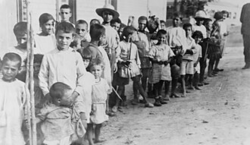The First World War, also known as World War I, broke out between Europe’s great powers in the summer of 1914, following decades of escalating tensions over a wide range of issues, from an arms race between Britain and Germany to rivalry for influence between Russia and the Austro-Hungarian Empire in the Balkans to competition between six or seven states for control of parts of Africa and Asia as colonies. The immediate spark for the war was the assassination of the heir to the Empire of Austria-Hungary, Archduke Franz Ferdinand, in the streets of Sarajevo by a Serb nationalist, Gavrilo Princip, on the 28th of June 1914. Matters escalated from there until most of Europe’s major powers had joined either the Entente led by France, Britain and Russia or the Central Powers led by Germany, Austria-Hungary and the Ottoman Empire. The war would drag on for over four years and was characterized by bitter trench warfare, particularly on the brutal Western Front in north-eastern France. When it came to an end in the early winter of 1918, it was followed by half a decade of civil wars, wars of independence, and revolutions as Europe’s old empires crumbled and were replaced by new states. In the process, there was mass dislocation and migration of people all across Europe.[1]
Chronology of eventsChronology of events
When World War I broke out across Europe in the final days of July 1914 and into early August, Europe’s most powerful states had not been involved in a continent-wide war with one another in the better part of a century. But tensions had been escalating for decades following the unification of Germany in 1871. This created problems in the balance of power in Europe as all sides feared the rise of an all-powerful Germany. Matters were compounded by competition to acquire colonies in Africa and Asia from the 1870s onwards, leading to diplomatic crises such as the Fashoda Incident between France and Britain in 1898 and the Agadir gunboat crisis between France and Germany. To complicate matters, Russia and Austria-Hungary were rivals to replace the declining Ottoman Empire as the dominant power in the Balkans. By the early 1910s, two major military alliances had formed as war became more and more likely, the Triple Entente between France, Britain, and Russia and the Triple Alliance between Germany, Austria-Hungary, and Italy.[2]
The long-anticipated war finally arrived in the summer of 1914, following the execution of Archduke Franz Ferdinand, the heir to the Austro-Hungarian Empire, in the streets of Sarajevo by a Serb nationalist named Gavrilo Princip on the 28th of June. Although the immediate response to this fairly localized event was relatively moderate, tensions escalated in July as both Russia and Austria-Hungary engaged in saber-rattling concerning the Balkans. Then Germany and Britain began antagonizing one another in defense of their allies. Finally, in the last days of July and the first days of August 1914, most of the great powers declared war on one another. The Ottoman Empire joined the war on Germany and Austria-Hungary’s side, though Italy would renege on its alliance agreement and instead eventually sided with the French, British, and Russians. The United States remained aloof until the spring of 1917, but finally joined the war on the side of the British and French at that juncture owing to German attacks on its shipping in the Atlantic.[3]

The conflict was characterized by trench warfare. This was the first major war in which machine guns and other devastating weapons of this kind were deployed and all sides found they could not achieve major breakthroughs on any front. Consequently, they became bogged down in trenches laid out over miles across north-eastern France, the Alps and in Poland and Ukraine, eventually leading to stalemates in many areas. The Western Front in France was by far the most important front and it was here that the war would be won or lost through bloody engagements like the First Battle of the Somme. However, in the end it was not on the battlefield that the war was decided, but internally in countries like Germany once their economies faltered and they ran out of resources, leading to revolution at home. It was this which brought about Germany’s surrender in November 1918, weeks after Austria-Hungary had effectively left the conflict as its centuries old empire collapsed internally.[4]
The war was followed by half a decade of civil wars, revolutions, and wars of independence. Perhaps the most well-known is the Russian Civil War which followed the Russian Revolution of 1917, but there were many others, notably the Turkish War of Independence, the German Revolution, the Irish War of Independence, and various other splinter wars from these such as the Finnish Civil War and the Greco-Turkish War. Throughout this near decade of war and revolutions, there was a mass movement of people across Europe to escape the conflicts and to move across new national boundaries.[5]
Extent of migrationExtent of migration
Some of the migration which occurred during this period was of people wishing to escape the bloodshed of the war itself. This was, quite obviously, most intense in north-eastern France, where the Western Front was located and where there were miles and miles of nothing but trenches and burnt-out countryside during the war. Approximately 150,000 French people left this region alone in August 1914, a figure that increased to half a million by the start of 1915, and the millionth refugee in France was recorded in December 1916. In total, upwards of two million French people became refugees owing to the war, though many returned home when the conflict ended.[6]
Much of the other migration actually occurred as the war came to an end and in the years that followed down to 1923. This was closely tied to the redrawing of Europe’s borders. As old empires, like those of the Russians, Ottoman Turks and Austro-Hungarians collapsed in 1917 and 1918, new, typically smaller states such as Poland, Türkiye, Hungary and Czechoslovakia emerged out of their ashes. In many instances, this led to either voluntary migration or extensive population transfers as these new states sought to create more racially ‘pure’ countries by expelling minority populations and welcoming people of their own alleged race from beyond their borders.[7]
Processes like this played out in many countries; for instance, the division of Ireland into Northern Ireland and the newly independent Irish Free State saw a boundary commission established in the early 1920s and Roman Catholics transferred from the north to the Free State, with tens of thousands of Protestants heading in the opposite direction.[8] Upwards of half a million people fled the emerging Soviet Union during the Russian Civil War, with many relocating to Poland. Under the terms of the Treaty of Neuilly-sur-Seine, which brought the war between Bulgaria and the victorious powers to an end in 1919, a population transfer between Greece and Bulgaria, whereby Bulgarians living in Greece would relocate to Bulgaria and vice-versa, was agreed upon.[9] On a somewhat different note, in France, which had lost many of its young adult males in the fighting between 1914 and 1918, immigration into the country to replace this lost labor and restore the gender balance was encouraged in the post-war years.[10]
Demographic impactDemographic impact
The demographic impact of all of this was immense. For instance, in Ireland, it created a more religiously monolithic Free State and Northern Ireland. More racially homogenous nation-states emerged in Bulgaria and Greece owing to the transfer of tens of thousands of people across their borders between 1919 and 1924. Something similar happened in many of the new countries which emerged out of the collapse of the Austro-Hungarian Empire as people voluntarily relocated to live closer to people of their own ethnicity.

The most substantial of all of these population transfers was undoubtedly that which occurred between Greece and Turkey. Greece became involved in the Turkish War of Independence in 1919, hoping to exploit the collapse of the Ottoman Empire to seize territories on the coastline of western Turkey where there was historically a large Greek population and some of the islands in the Eastern Mediterranean controlled by the Turks. This went well at first, but in 1921 and 1922 the Greeks suffered a series of reverses and eventually made peace with Turkey on the basis of returning to their pre-war borders. Both countries also agreed to a population transfer whereby Greeks would leave Turkish territory and be resettled in Greece and vice-versa; over the next several years, at least 1.6 million people were transferred between the two countries. Of these approximately three-quarters were Greek Orthodox Christians who left Anatolia and other parts of Turkey for Greece, with only a quarter consisting of Muslims moving in the opposite direction.[11]
World War I record collections on MyHeritageWorld War I record collections on MyHeritage
United States:
- United States, World War I Draft Registration, 1917-1918
- Kansas, World War I Bounty Claims
- Arkensas, World War I Discharge Records
- Tennessee World War I Veterans
- Gold Star Honor Roll. a Record of Indiana Men And Women Who Died in the Service of the United States And the Allied Nations in the World War. 1914-1918
- Illinois in the World War, Volume 1, History of the 33rd Division, A.E.F.
- Illinois in the World War, Volume 2, History of the 33rd Division, A.E.F.
- Ohio in the Rainbow: Official Story of the 166th Infantry, 42nd Division in the World War
- History of the 89th Division, U. S. A.: From Its Organization in 1917, Through Its Operations in the World War, the Occupation of Germany And Until Demobilization in 1919
United Kingdom:
- British Red Cross Society Volunteers, 1914-1918
- The National Roll of the Great War, 1914-1918
- United Kingdom, Index of Merchant Seamen’s Campaign Medals, 1914-1918
- United Kingdom, Admiralty and War Office: Royal Naval Division: Records of Service, 1914-1919
Australia & New Zealand:
- New Zealand, World War I Service Personnel Reserves Index
- Australia, First World War Embarkation Rolls
- Australia, First World War Nominal Roll, 1914-1918
- Australia, Queensland, World War I Soldier Portraits 1914-1918
- New Zealand Division
Continental Europe:
See alsoSee also
Research military records on MyHeritageResearch military records on MyHeritage
Explore more about US World War I draft recordsExplore more about US World War I draft records
- Military records on MyHeritage
- The Great War: Researching Your World War I Ancestors, webinar by Michael L. Strauss, AG on Legacy Family Tree Webinars
- World War I: Women's Lives During the War, webinar by Gena Philibert-Ortega on Legacy Family Tree Webinars
- World War I Draft Registrations: Find Military Records of Ancestors Who Fought in WWI on the MyHeritage Knowledge Base
- How to Find Records with the MyHeritage search engine on the MyHeritage Knowledge Base
- Death and Burial Practices in World War I and WW II webinar by Rick Sayre on Legacy Family Tree Webinars
- Thankful villages – the impact of World War One on communities webinar by Kirsty Gray on Legacy Family Tree Webinars
- African Americans in the Army: 1868-1948 on Legacy Family Tree Webinars
- The Fromelles Genealogy Project: Reuniting WW1 Soldiers with their Families on Legacy Family Tree Webinars
- Soldiers & Rebels: Tracing Your WW1 and Irish Revolutionary Ancestors on Legacy Family Tree Webinars
- Spies, Slackers, and Aliens: Records of the American Protective League on Legacy Family Tree Webinars
- Tracing a World War One Soldier from US to Europe and Back Again on Legacy Family Tree Webinars
- World War I: Women's Lives During the War on Legacy Family Tree Webinars
- Over the Top: Researching Canadians in the First World War on Legacy Family Tree Webinars
References
- ↑ World War I. History Channel
- ↑ The European Scramble. BBC
- ↑ July Crisis 1914. International Encyclopedia of the First World War
- ↑ Timeline (1914 - 1921). Library of Conngress
- ↑ When did the First World War really end?. Imperial War Museums
- ↑ Refugees (France). International Encyclopedia of the First World War
- ↑ The Legacy of World War I. CNRS
- ↑ Dáil Éireann debate - Thursday, 19 Nov 1925. Houses of the Oireachtas
- ↑ “A Bad and Vicious Solution”. The Lausanne Project
- ↑ Cross, Gary S.Toward Social Peace and Prosperity: The Politics of Immigration in France during the Era of World War I. French Historical Studies, Vol. 11, No. 4 (Autumn, 1980), pp. 610-632
- ↑ Greece and Turkey: The Treaty of Lausanne 100 years on. Deutsche Welle

